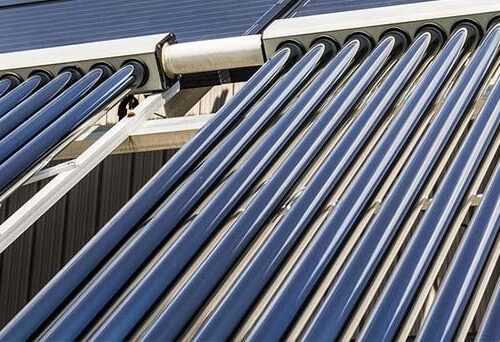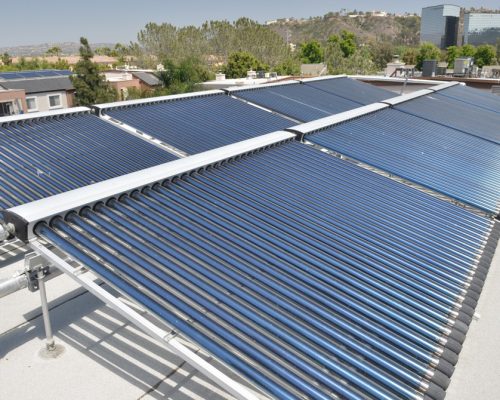The Miracles of Solar Thermal Systems
The world relies heavily on the power generation sector, which has historically used water or oil to generate electricity and heat energy. However, massive widespread usage around the globe has resulted in the depletion of both these natural resources. Renewable energy, such as sunlight and geothermal energy, has become more promising than oil and water. One such renewable form of energy is solar power, which can help generate electricity and thermal energy to serve the power and heating requirements of households, commercial units, and industries. A more recent application of solar energy is domestic heating. Traditional central heating systems use hot water from boilers, which run on natural gas, oil, LPG, or electricity. A solar thermal system is a substitute for all these resources and heats your boiler with the help of sunlight. So, what is included in a solar thermal system, and how it works?
The Components of a Solar Thermal System
A solar thermal system draws sunlight and uses it to heat your boilers so that you can have an uninterrupted supply of hot water which can subsequently be used for various purposes, such as supplying your underfloor heating system or your central heating system. These systems need several components, including:
- Solar Thermal Panels or Collectors
- Pumps
- Controllers
- Water Cylinders


The Structure and Operations of Solar Collectors
Solar collectors comprise several elements:
- Cover: The cover is usually constructed from glass to enhance convection and minimize heat loss. Special plastic covers can also be used with the same properties.
- Air Channel: The absorbent plate is separated from the cover with an air channel, with or without a vacuum. The width of the channel is taken into consideration for minimizing heat losses.
- Absorbent Plate: These plates absorb solar energy and then transmit the heat to the fluid circulating through the pipes. The plates should have a high solar absorption ability and minimum thermal emission.
- Ducts or Pipes: Pipes or ducts are connected or welded to the absorbent plates to enhance heat exchange.
- Insulating Layer: An insulating layer with minimum thermal conductivity covers the system to ensure minimum heat losses.
Installing and Selecting the Type of Collectors
The collectors are mounted in a location where there is maximum exposure to sunlight. They can be mounted on the roof or the ground depending on the more suitable. A transfer fluid which is usually a mixture of water and an anti/freeze agent, is circulated throughout the system, i.e. from the water cylinder down in your home through a pump to the collectors. The collectors capture the heat generated by sunlight and heat the transfer fluid, which flows back to the water cylinder. Within the cylinder is a heat exchanger. Hot water passes through the heat exchanger tubes and heats the water in the cylinder. There are two types of collectors;
- Flat Plate Collectors
- Evacuated Tube Collectors
-
Flat Plate Collectors
These are the most commonly used collectors in domestic systems. They
have three components:
- Flat metal plates for intercepting and absorbing solar energy.
- Transparent cover so that solar energy can pass through it easily, thus reducing the absorber’s heat loss.
- An insulation layer on the absorber’s back for reducing heat losses.
Flat plate collectors have metal tubes attached to the absorber. The transfer fluid is circulated through the absorber tubes for removing heat from the absorber and transferring the heat to the water in a storage tank.
These systems are suitable for maintaining temperatures between 86 to 160°F.


-
Vacuum Tube or Evacuated Tube Collectors
Unlike flat panels, vacuum tube collectors have several tubes usually constructed from glass. Each tube has two glass tubes with a vacuum between them that reduces heat loss. The transfer fluid flows through these tubes and gets heated more rapidly than a flat collector. These systems are highly suitable in considerably cold environments as there is minimum heat loss, and the fluid retains most of its heat. They can help you maintain temperatures ranging from 170 to 350 °F. They are relatively more expensive than flat plate collectors.
Water Cylinders
Storage tanks for collecting and storing hot water are also essential for solar thermal systems. Cold water enters the tank right below the accumulator and comes in contact with the heat exchanger. As the water is heated through heat exchange, it moves upwards towards the outlet from where it is supplied to your heating system. You can choose between two types of storage tanks for domestic heating through solar panels: A single system and a dual system. A single system includes one water cylinder and one heat exchanger, supplying water for either drinking purposes or your heating system. The dual system includes two water cylinders, one for drinking water and the other for your heating system. It also has two heat exchangers. The tanks are usually insulated to minimize heat loss. The capacity of the storage tanks should be decided according to your water requirements.
Hydraulic Pumps
A solar thermal system needs simple hydraulic pumps to operate efficiently. The desired power of the pumps depends on the location of the thermal panels and their distance from the storage tanks. It is best to install two pumps instead of one to reduce wear and tear. The pump is needed to supply water from the ground level to your thermal panels. You may also need an additional pump if your solar panels are located on the ground level.
-
Pipes and Ducts
The entire piping network should be insulated to further reduce heat loss. Piping will be required to complete the recirculation network, i.e., from the storage tank to the thermal panels and back.


Control Panel
Solar thermal systems come with full or semi-automatic control panels to have complete control. These controlling systems include advanced temperature sensors and will automatically supply the storage tank with hot water when the transfer fluid in the collectors reaches a suitable temperature. Some latest smart systems will let you connect your system to your smartphone and provide you with efficiency reports whenever you retrieve them.
The Circuit of a Solar Thermal System
The solar thermal system can be divided into a primary and a secondary circuit for understanding. The primary circuit is closed and transmits heat energy from the collectors to the accumulators (storage). The transfer fluid, after transferring its heat to the cold water, circulates back to the collector for reheating. The secondary circuit deals with consumption. Cold water enters the water tank while hot water exits from it and is used up by your central heating system, underfloor heating, and for personal hygiene. Together, these two circuits produce and supply hot water for your home.
Benefits of a Solar Thermal System
- A solar thermal system creates a safer and healthier environment for everyone. No more depletion of natural resources like natural gas or oil.
- They are much safer than boilers that use other fuels and emit no carbon monoxide. Natural gas and carbon monoxide are both hazardous gases.
- Solar thermal systems provide you with an uninterrupted hot water supply without the need to be connected to the national grid.
- You can expect to save more than 60% energy on heating water and 35% on heating your home.
- With advanced controllers, you can completely control your solar thermal system and supply your home with just the right amount of hot water without waste.
Tips on Getting the Best System
- Always look for experienced companies or professionals when you opt for a solar thermal system. These are highly complex systems, and even a small error can eliminate the benefits of a solar thermal system.
- Inquire about the warranty of solar thermal systems before buying them.
- If money is not a problem, try opting for the evacuated tube collector, as it is more efficient.
- Try to keep the distance between your storage tank and collectors at a minimum.
- Get your piping properly insulated for minimum heat loss.
- When installing solar panels, install them at a location that gets maximum sunlight.
- Before buying a system, check if your current boiler is compatible with the solar thermal system. Usually, conventional and system boilers can easily connect to the solar system. However, combi-boilers will require the addition of a storage tank.
- Although you do not need planning permission to install a solar thermal system but do check it with your local council.
- Get a storage tank with a suitable capacity to maximize the benefits of solar thermal systems

